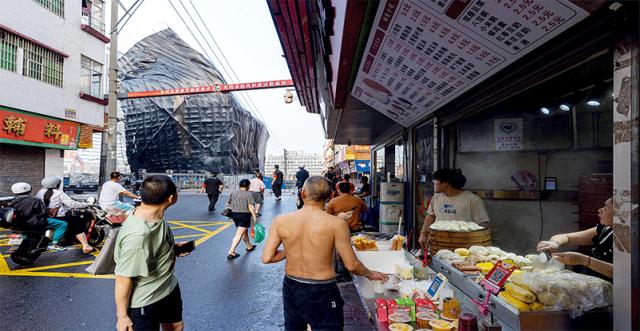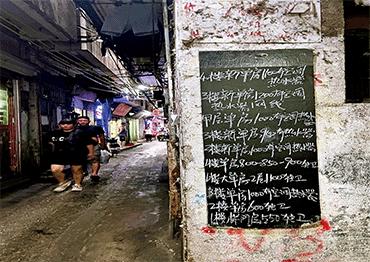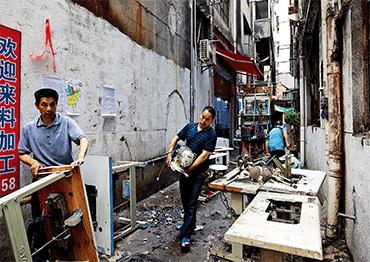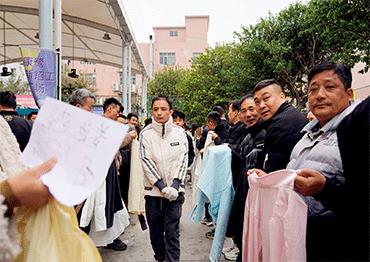The renovation of Kanglu comes as China is changing how it goes about renovating urban villages.
When the Kanglu project was first mooted in 2011, residents of both villages agreed and started seeking potential partners. In 2018 the two villages combined voted for the renovation. In 2021, real estate company Hopson was appointed to develop the area. At the time, they would have expected high compensation offers, and to be able to rent out the new properties for more money.
In June 2023, Haizhu District established an office to oversee the project, and finally began to push for progress. After the first demolitions at the end of 2023, plans and consent for construction were approved in early summer of 2024, and in July, construction started.
The gap of more than a decade between agreeing to the project and its implementation has seen a huge change in the way urban villages are transformed. A decade ago, urban village transformation in Guangzhou was completely market-oriented and led by real estate companies focused only on short-term profit, like building as many commercial housing developments as they could. At that time, the real estate market was booming. Now, with more concerns over long-term regional development and public welfare, areas such as enhancing infrastructure, improving living conditions and enhancing industrial upgrading are prioritized.
The old way was more efficient. Led by property developers, they offered much more attractive compensation. Reaching agreement was much easier. But Li Yujia pointed out that overreliance on property developers led to high levels of compensation for homeowners who held out, and raising overall costs. This became a hurdle when governments offered their own compensation standards.
Then to ensure maximum profits, developers often ignored the agreed planning permissions, building bigger homes while disregarding the required public facilities they were supposed to build. Ultimately, the property companies dominated the renovation projects, Li Yujia said.
The recession in the property market has put paid to this way of dealing with urban village renovation. Li Xiaojiang, former director of China Academy of Urban Planning & Design, said the previous demolition compensation system was smooth because there was sufficient demand in the real estate market. Even though the compensation was high, developers constructed more buildings to make up for the loss, and local authorities made more money through leasing the land. Now it is unclear who will be responsible for reconstruction after demolition, especially as now there are increased government requirements for infrastructure and affordable housing, Li Xiaojiang noted.
In 2023, the central government emphasized several times the importance of promoting urban village renovation in big cities. In July that year, the State Council issued a guideline, emphasizing a people-centered approach to urban transformation, prioritizing improvements to residential environments. The government is to take the lead in leveraging market forces. The guideline also mentioned the need for industrial upgrades and the development of a proportion of affordable housing.
Guangzhou put forward its 2021- 2035 plan for urban village transformation the same year, highlighting the role of government and encouraging State-owned companies to get involved. Starting from May 1, the city implemented a regulation on urban village transformation, the first regional regulation to put urban village transformation on a legal track. It also marks a fundamental change in the transformation model in big cities like Guangzhou, from short-term and real estate-oriented investment and development models to emphasizing long-term and comprehensive public welfare.
Kanglu is subject to the new development regime. In May, Guangzhou published guidelines for transforming old villages, factories and towns, with detailed requirements for approved projects in terms of industrial development, infrastructure facilities and affordable housing.
Li Yujia said that the transformation of Kanglu will not be easy. Even though the floor area ratio and affordable housing requirements are not as high as in the new model, the government hopes more room can be provided for long-term development of the city to boost industrial upgrading, with housing provided for migrant populations. It wants the real estate company to balance the books on the project. “The landing of a project is rather slow as a result,” Li Yujia noted.
In March and April, Li Yujia joined local seminars on transformation. He told NewsChina that real estate developers are particularly concerned about maintaining equilibrium in cash flow during projects amid the decline in the property development market. The longer a project is delayed, the more financial pressure they are under. Local authorities are trying to persuade Kanglu villagers to accept the compensation to ensure the project continues.
Several experts familiar with the project believe it will take time for villagers to lower their expectations, and this will be hard to push forward relying on the government alone. The market will make them truly feel the plummeting housing price.
Kanglu property owners told NewsChina they are in favor of improving the general environment. They are not in danger of losing their primary residence, as most have moved out and are not involved in the textile business. But they still want to rent out the new properties to provide their income.
It is a case of balancing the needs of individuals with the overall needs of the village and the wider city.
For such industrial villages, just demolition and rebuilding might not necessarily solve problems like safety hazards and governance chaos if there is no strong management, according to Li Xiaojiang. He suggested the first two plots to be developed should become a pilot project. It will still take time for demolition in the area to spread.
“It might be worthwhile to see how enterprises in the new buildings feel, and how well the property management is handling safety. If successful, it can be copied. But if there are still safety issues, for example, the local government should develop more effective renewal measures. In some areas, organic renewal, such as improving infrastructure, may be more appropriate,” Li Xiaojiang said.
He added that Kanglu’s transformation is a matter of economic development. “Laws of the market should be respected while exploring a comprehensive method for the village that not only reduces risks and protects villagers’ legitimate interests, but also helps enterprises operate effectively and new residents settle down and prosper,” Li Xiaojiang said.
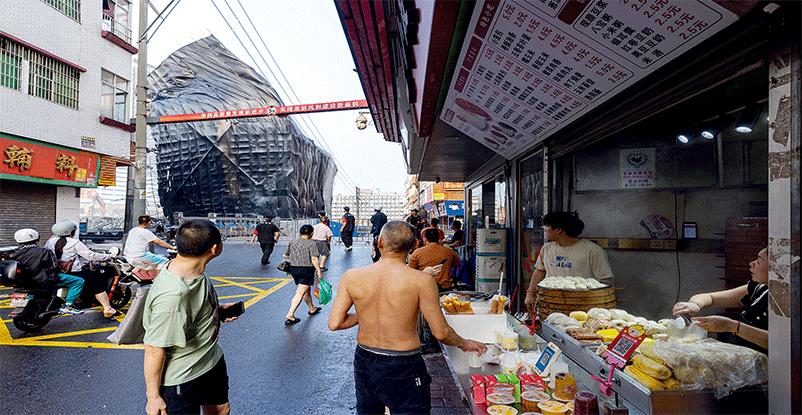
 Old Version
Old Version
